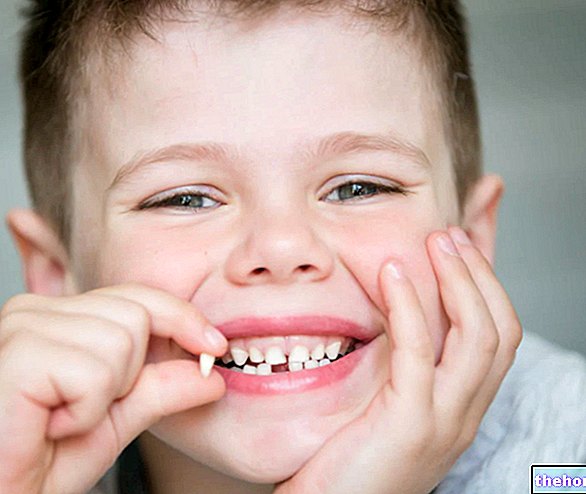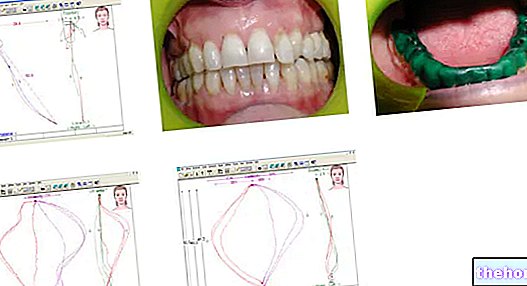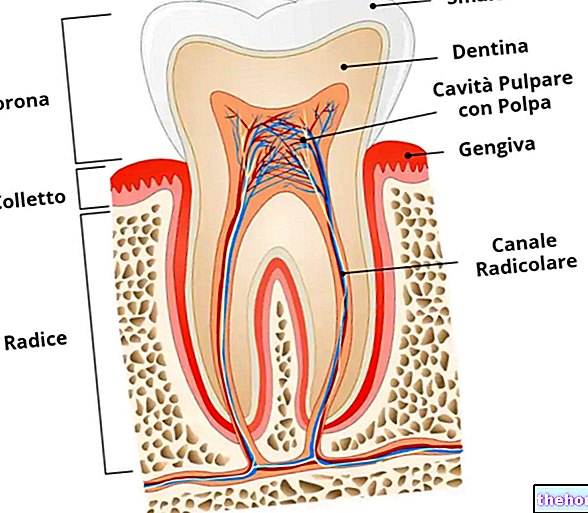
The best known and most common responsible for dental stains are foods such as tea, cocoa and coffee, but also chewing tobacco, incorrect oral hygiene and smoking in general.
at an advanced stage, favored by "incorrect oral hygiene and the habitual consumption of too acidic substances (citrus juices, wine, carbonated drinks, tablets of certain drugs or supplements - such as aspirin and vitamin C - chewed rather than swallowed ....) and / or too sweet (cakes, chocolates, candies, honey, sugar, sweet snacks, jams ...). Another less common cause of black teeth is drug abuse, especially methamphetamines or marijuana smoke ( the spots, ranging from brown to black, appear as dark rings surrounding the teeth near the gums.) The presence of very evident dark gray spots may be due to the particular chemical composition of the amalgams used until a few years ago for dental restorations.
Blue-gray spots
The intake of particular antibiotics (tetracyclines) during fetal life (through the mother), in the neonatal period and in early childhood, can cause rather unpleasant dental discolorations, leading to the formation of spots ranging from gray-blue to black, from yellow to brown. In adults, antibiotic dyschromia may arise in case of prolonged use and / or high doses of minocycline, a tetracycline used in the treatment of acne and rheumatoid arthritis: the higher the dose, the longer the therapy, the more persistent and evident are the spots. Gray spots on the tooth can also be the result of bleeding processes caused by trauma or dental procedures.
Brown spots
Chlorhexidine-based mouthwashes - recommended in the presence of chronic gingivitis, very aggressive carious diseases or major problems of the periodontium - are very often associated with the presence of brown spots on the teeth and tongue. This requires a thoughtful use of mouthwash: no more than twice a day for periods of two to three weeks, and only on the dentist's prescription.
Blue-green or metallic spots
This problem can affect those who work closely with metals, for example in the chemical industry, frequently exposing themselves to substances such as iron, silver and manganese (black teeth), mercury, copper, nickel and lead dust (green-blue spots) , inhalation of fumes such as chromic acid (orange-intense spots), or swimming pool chlorine (brown teeth).
Yellow or brown spots
They are common in heavy smokers and in those used to chew tobacco (yellow-brown or black spots) or consume a lot of coffee, tea, licorice and sodas containing caffeine and caramel. In addition, teeth can turn yellow due to the natural aging process. Cariogenic processes in the initial stage also present themselves in the form of dull-yellow spots. Finally, a common cause of yellow teeth is the lack of oral hygiene: we must not forget that the color of the teeth is genetically influenced and mainly depends on the thickness of the enamel (translucent white color) and the underlying dentin.
Spots associated with a jagged appearance
Excess fluoride (fluorosis) can cause tooth stains ranging from white-gray to brownish and black, depending on the severity of the intoxication. In children under the age of 8, dental discoloration from fluorosis is also associated with demineralized and damaged teeth, also common to those who consume an excess of acidic foods or grind their teeth frequently (bruxism).
Other articles on "Stains on the teeth"
- Yellow teeth
- White teeth
- Teeth Whitening
- Teeth whitening products
- Teeth whitening with the laser
- Natural teeth whitening
- Whitening pen for whiter teeth





.jpg)






















